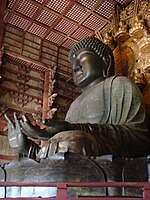Nichiren
This article has multiple issues. Please help improve it or discuss these issues on the talk page. (Learn how and when to remove these template messages)
No issues specified. Please specify issues, or remove this template. |
Nichiren (日蓮) | |
|---|---|
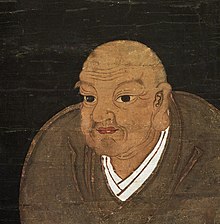 A painting of Nichiren, kept at Kuon-ji Temple, Mt. Minobu. | |
| Title | Founder of Nichiren Buddhism |
| Personal | |
| Born | February 16, 1222 |
| Died | October 13, 1282 (age 60) |
| School | Mahayana, Nichiren |
Nichiren (日蓮) (February 16, 1222 – October 13, 1282) was a Buddhist monk who lived during the Kamakura period (1185–1333) in Japan. Nichiren taught devotion to the Lotus Sutra, entitled Myōhō-Renge-Kyō in Japanese, as the exclusive means to attain enlightenment and the chanting of Nam-Myōhō-Renge-Kyō as the essential practice of the teaching. Nichiren Buddhism includes various schools with diverging interpretations of Nichiren's teachings. While virtually all Nichiren Buddhist schools regard him as a reincarnation of the Lotus Sutra's Bodhisattva Superior Practices, Jōgyō Bosatsu (上行菩薩), some schools of Nichiren Buddhism's Nikkō lineages regard him as the actual Buddha of this age, or the Buddha of the Latter day of the Law.[1]
Lifetime
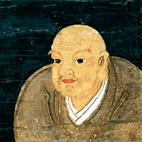
| Part of a series on |
| Buddhism |
|---|
 |
| Part of a series on |
| Buddhism in Japan |
|---|
 |
Birth, education, initial teaching
Nichiren was born on February 16, 1222 in the village of Kominato, Nagase District, Awa Province (within present-day Chiba Prefecture). Nichiren's father was Mikuni-no-Tayu Shigetada, also known as Nukina Shigetada Jiro (d. 1258) and his mother was Umegiku-nyo (d. 1267). On his birth, his parents named him Zennichimaro (善日麿) which has variously been translated into English as "Splendid Sun" and "Virtuous Sun Boy" among others. The exact site of Nichiren's birth is believed to be submerged off the shore from present-day Kominato-zan Tanjō-ji (小湊山 誕生寺), a temple in Kominato that commemorates Nichiren's birth. In his own words about his birth, Nichiren stated that he was "the son of a chandala family who lived near the sea in Tojo in Awa Province, in the remote countryside of the eastern part of Japan."[2]
Nichiren began his Buddhist study at a nearby temple of the Tendai school, Seichō-ji (清澄寺, also called Kiyosumi-dera), at age 11. He was formally ordained at 16 and took the Buddhist name Zeshō-bō Renchō. He left Seichō-ji shortly thereafter to study in Kamakura and several years later traveled to western Japan for more in-depth study in the Kyoto–Nara area, where Japan's major centers of Buddhist learning were located. During this time, he became convinced of the pre-eminence of the Lotus Sutra and in 1253, returned to Seichoji.
On April 28, 1253, he expounded Nam Myōhō Renge Kyō for the first time, marking his Sho Tempōrin (初転法輪: "first turning the wheel of the Law"). With this, he proclaimed that devotion and practice based on the Lotus Sutra was the correct form of Buddhism for the current time. At the same time he changed his name to Nichiren, nichi (日) meaning "sun" and ren (蓮) meaning "lotus". This choice, as Nichiren himself explained, was rooted in passages from the Lotus Sutra.
After making his declaration, which all schools of Nichiren Buddhism regard as marking their foundation (立宗: risshū), Nichiren began propagating his teachings in Kamakura, then Japan's de facto capitol since it was where the shikken (regent for the shogun) and shogun lived and the government was established. He gained a fairly large following there, consisting of both priests and laity. Many of his lay believers came from among the samurai class.
First remonstrance with authorities and early years
Nichiren criticized other Buddhist schools for their manipulations of the populace for political and religious control. Citing Buddhist sutras and commentaries, Nichiren argued that the Buddhist teachings were being distorted for their own gain (see the compilation of Nichiren's exchanges with government leaders and Buddhist practitioners in "The Writings of Nichiren Daishonin" 1999).
Some groups[who?] today characterize Nichiren's efforts as an attempt to reform the Buddhist schools of Japan. Through his writings, it seems that Nichiren was not trying to reform other sects. Nichiren stated this clearly, in his Risshō Ankoku Ron[3] (立正安国論): "Treatise On Establishing the Correct Teaching for the Peace of the Land"[4]), his first major treatise and the first of three remonstrations with government authorities. He felt that it was imperative for the sovereign to recognize and accept the singly true and correct form of Buddhism (i.e., 立正: risshō) as the only way to achieve peace and prosperity for the land and its people and end their suffering (i.e., 安国: ankoku). This "true and correct form of Buddhism", as Nichiren saw it, entailed regarding the Lotus Sutra as the fullest expression of the Buddha's teachings and putting those teachings into practice. Nichiren thought this could be achieved in Japan by withdrawing lay support so that the deviant monks would be forced to change their ways or revert to laymen to prevent starving.
Based on prophecies made in several sutras,[5] Nichiren attributed the occurrence of the famines, disease, and natural disasters (especially drought, typhoons, and earthquakes) of his day to teachings of Buddhism no longer appropriate for the time.
Nichiren submitted his treatise in July 1260. Though it drew no official response, it prompted a severe backlash, especially from among priests of other Buddhist schools. Nichiren was harassed frequently, several times with force, and often had to change dwellings.

Nichirō agreed with Nisshō's defense of Nichiren as a Tendai reformer[citation needed]. He founded a practice hall that became part of Ikegami Honmon-ji, the site of Nichiren's death. His school is now part of Nichiren-shū.
Nichiren was exiled to the Izu peninsula in 1261, and pardoned in 1263. He was ambushed and nearly killed at Komatsubara in Awa Province in November 1264.
Failed execution attempt
The following several years were marked by successful propagation activities in eastern Japan that generated more resentment among rival priests and government authorities. After one exchange with the influential priest, Ryōkan (良観), Nichiren was summoned for questioning by the authorities in September 1271. He used this as an opportunity to make his second government remonstration, this time to Hei no Saemon (平の左衛門, also called 平頼綱: Taira no Yoritsuna), a powerful police and military figure who issued the summons.
Two days later, on September 12, Hei no Saemon and a group of soldiers abducted Nichiren from his hut at Matsubagayatsu, Kamakura. Their intent was to arrest and behead him. According to Nichiren's account, an astronomical phenomenon — "a brilliant orb as bright as the moon" — over the seaside Tatsunokuchi execution grounds terrified Nichiren's executioners into inaction.[6] The incident is known as the Tatsunokuchi Persecution and regarded as a turning point in Nichiren's lifetime called Hosshaku kenpon (発迹顕本).
Unsure of what to do with Nichiren, Hei no Saemon decided to banish him to Sado, an island in the Japan Sea known for its particularly severe winters and a place of harsh exile.
This exile, Nichiren's second, lasted about three years and, though harsh and in the long term detrimental to his health, represents one of the most important and productive segments of his life. While on Sado, he won many devoted converts and wrote two of his most important doctrinal treatises, the Kaimoku Shō (開目抄: "On the Opening of the Eyes" [7] and the Kanjin no Honzon Shō (観心本尊抄: "The Object of Devotion for Observing the Mind"[8] as well as numerous letters and minor treatises whose content containing critical components of his teaching.
It was also during his exile on Sado, in 1272, that he inscribed the first Gohonzon (御本尊). This mandala is a visual representation, in Chinese characters, of the Ceremony in the Air. This ceremony is described in the 11th (Treasure Tower) to 22nd (Entrustment) chapters of the Lotus Sutra. Within these chapters it is revealed that all persons can attain Buddhahood in this lifetime and Shakyamuni transfers the essence of the sutra to the Bodhisattvas of the Earth led by Bodhisattva Superior Practices (Jogyo), entrusting them with the propagation of the essence of the sutra in the Latter Day of the Law. For Nichiren, the Gohonzon embodies the eternal and intrinsic Law of Nam-Myoho-Renge-Kyo, which he identified as the ultimate Law permeating life and the universe.
Nichiren was pardoned in February 1274 and returned to Kamakura in late March. He was again interviewed by Hei no Saemon, who now was interested in Nichiren's prediction of an invasion by the Mongols. Mongol messengers demanding Japan's fealty had frightened the authorities into believing that Nichiren's prophecy of foreign invasion would materialize (which it did in October; see Mongol Invasions of Japan). Nichiren, however, used the audience as yet another opportunity to remonstrate with the government.
Retirement to Mt. Minobu
His third remonstration also went unheeded, and Nichiren—following a Chinese adage that if a wise man remonstrates three times but is ignored, he should leave the country—decided to go into voluntary exile at Mt. Minobu (身延山) in 1274.
With the exception of a few short journeys, Nichiren spent the rest of his life at Minobu, where he and his disciples erected a temple, Kuon-ji (久遠寺), and he continued writing and training his disciples. Two of his works from this period are the Senji Shō (撰時抄: "The Selection of the Time")[9]and the Hōon Shō (報恩抄: "On Repaying Debts of Gratitude")[10], which, along with his Risshō Ankoku Ron (立正安国論: "On Establishing the Correct Teaching for the Peace of the Land"), Kaimoku Shō ("The Opening of the Eyes"), and Kanjin no Honzon Shō ("The Object of Devotion for Observing the Mind"), constitute his Five Major Writings. He also inscribed numerous Gohonzon for bestowal upon specific disciples and lay believers. Many of these survive today in the repositories of Nichiren temples such as Taiseki-ji (大石寺) in Fujinomiya, Shizuoka Prefecture, which has a particularly large collection that is publicly aired once a year in April.
Death
Nichiren spent his final years writing, inscribing Gohonzon for his disciples and believers, and delivering sermons. In failing health, he was encouraged to travel to hot springs for their medicinal benefits. He left Minobu in the company of several disciples on September 8, 1282.
He arrived ten days later at the residence of Ikegami Munenaka, a lay believer who lived in what is now Ikegami, the site is marked by Ikegami Honmon-ji. On September 25 he delivered his last sermon on the Risshō Ankoku Ron, and on October 8 he appointed six senior disciples—Nisshō (日昭), Nichirō (日朗), Nikkō (日興), Nikō (日向), Nichiji (日持), and Nitchō (日頂)—to continue leading propagation of his teachings after his death. Nichiren Shoshu believe that Nichiren designated five senior priests, and one successor, Nikko.
On October 13, 1282, Nichiren died in the presence of many disciples and lay believers. His funeral and cremation took place the following day. His disciple Nikkō left Ikegami with Nichiren's ashes on October 21, reaching Minobu on October 25. Nichiren's original tomb is sited, as per his request, at Kuonji on Mt. Minobu.
Writings
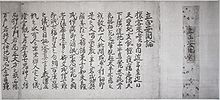
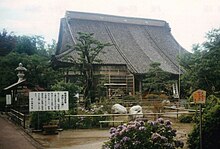

Some Nichiren schools refer to the entirety of Nichiren's Buddhism as his "lifetime of teaching". Many of his writings still exist in his original hand, some as complete writings and some as fragments. Others survive as copies made by his immediate disciples. His existing works number over 700, including transcriptions of orally delivered lectures, letters of remonstration and illustrations[11]. Nichiren declared that women could attain enlightenment[12][13][14], therefore a great number of letters were addresses to female believers. Some schools within Nichiren Buddhism consider this to be a unique feature of Nichiren's teachings and have published separate volumes of those writings[15].
In addition to treatises written in kanbun (漢文), a formal writing style modeled on classical Chinese that was the language of government and learning in contemporary Japan, Nichiren also wrote expositories and letters to disciples and lay followers in mixed-kanji–kana vernacular as well as letters in simple kana for believers who could not read the more-formal styles, particularly children.
Some of Nichiren's kanbun works, especially the Risshō Ankoku Ron, are considered exemplary of the kanbun style, while many of his letters show unusual empathy and understanding for the down-trodden of his day. Many of his most famous letters were to women believers, whom he often complimented for their in-depth questions about Buddhism while encouraging them in their efforts to attain enlightenment in this lifetime.
During the pre-World War II period the Japanese government ordered Nichiren sects to delete various passages from his writing which were considered by the military government as a challenge to the supremacy of the emperor.[16][dubious – discuss]
Nichiren's Major Writings
The Five Major Writings that are common to all Nichiren Schools [17][18] are:
- On Establishing the Correct teaching for the Peace of the Land (J. Rissho Ankoku Ron) - written between 1258-1260 CE.[19]
- The Opening of the Eyes (J. Kaimoku-sho) - written in 1272 CE.[20]
- The Object of Devotion for Observing the Mind(J. Kanjin-no Honzon-sho) - written in 1273 CE.[21]
- The Selection of the Time (J. Senji-sho) - written in 1275 CE.[22]
- On Repaying Debts of Gratitude (J. Ho'on-sho) - written in 1276 CE.[23]
Nichiren Shoshu and SGI revere Ten Major Writings of Nichiren. These are the five listed above, and also[24]:
- On Chanting the Daimoku of the Lotus Sutra (J. Sho-hokke Daimoku-sho) - Written in 1260 CE.[25]
- On Taking the Essence of the Lotus Sutra (J. Hokke Shuyo-sho) - written in 1274 CE.[26]
- On the Four Stages of Faith and the Five Stages of Practice (J. Shishin Gohon-sho) - written in 1277 CE.[27]
- Letter to Shimoyama (J. Shimoyama Gosho-soku) - written in 1277 CE.[28]
- Questions and Answers on the Object of Devotion (J. Honzon Mondo-sho) - written in 1278 CE.[29]
Nichiren and Mahayana Buddhism
The Kamakura period of 13th century Japan, in which Nichiren was born - was characterised by natural disasters, internal strife and confusion within Mahayana schools about whether: "...the world had further entered a period of decline" referring to the Latter Day of the Law.[30] Nichiren attributed the turmoil in society to the invalid teachings of the Buddhist schools of his time, including the Tendai sect in which he was ordained: "It is better to be a leper who chants Nam-myōhō-renge-kyō than be a chief abbot of the Tendai school".[31] Setting out to declare his own teachings of Buddhism, Nichiren started at the age of 32 by denouncing all Mahayana schools of his time and by declaring the correct teaching as the Universal Dharma (Nam-Myōhō-Renge-Kyō) and chanting as the only path for personal and social salvation.[32] At the age of 51, Nichiren inscribed the Object of Devotion in Buddhism, the Gohonzon,"never before known" as he described it.[33] Other contributions to Buddhism were the teaching of The Five Guides of Propagation,[34] The doctrine of the Three Great Secret Laws[35] and the teaching of The Three Proofs[36] for verification of the validity of Buddhist doctrines. All these contributions were unknown to Mahayana schools of his time. Another difference between Nichiren Buddhism and almost all schools of Mahayana is the understanding of the Latter day of the Law, Mappō. Mahayana teaches that the current age is that of decline of Shakyamauni’s Buddhism[37] and that a Future Buddha[38] will appear to start Buddhism anew. Nichiren, on the other hand, confirms that his teachings of Buddhism will flourish for all eternity,[39][40] and that the Bodhisattvas of the Earth will propagate Buddhism in the future.[41]
Nichiren's views
1- Revealing the “Direct Path to Enlightenment”: The path to enlightenment in pre-Lotus Sutra teachings extends gradually throughout many Bodhisattva stages requiring many lifetimes before reaching Buddhahood. The Lotus Sutra, however, teaches that Buddhahood is already inherent within one’s current life. The Bodhisattva practice of the Lotus Sutra is based on directly revealing one’s Buddha nature without gradual stages. Nichiren writes: "Those who practice the Lotus Sutra are pursuing through this single act of devotion - the mind that is endowed with all manner of fortunate results. These are present simultaneously and are not acquired gradually over a long period of time. This is like the blossom of the lotus that, when it opens, already possesses a large number of seeds".[42] From an SGI perspective, the Bodhisattva practice (cause) and the revealing of Buddhahood (effect) are inseparable: "Anyone who practices this Law [of the Lotus] will obtain both the cause and the effect of Buddhahood simultaneously".[43] According to SGI, the essence of the Lotus Sutra, which integrates all the Buddha’s teachings - is fully contained within its title : “Myoho-Renge-Kyo”: "Therefore, one should understand that the [title] of the Lotus Sutra represents the soul of all the sutras".[44] According to SGI, Nichiren viewed the words of the sutras as expressions of the mind of the Buddha, and further revealed that all the teachings of the Buddha are encoded within the single phrase of “Myoho-Renge-Kyo”, meaning: the “Wonderful Law of the Lotus Flower Sutra”, or the “Universal Law of Cause and Effect”, also referring to it as the “ultimate reality” of life.[45] According to SGI, the way of “attaining enlightenment” requires a dedicated practice of devoting one’s life (namu) to the Universal Law or the Dharma. The Sanskrit word Namu means “devotion to" : "The word namu expresses feelings of reverence and a sense of compliance".[46]
2- Establishing the Object of Devotion: For almost 2000 years after Shakyamuni’s death, followers of the Buddha prayed to figurative statues of him as their object of devotion. According to Nichiren, using statue in prayers was suitable for the former periods of Buddhist practice, while in the current age (the Latter Day of the Law), statues and paintings - depicting the Buddha - will lose their power to benefit people.[47] A parallel to this view (of traditional Buddhist practice in the Latter Day becoming powerless) - is found in the Buddhist eschatology of Mahayana Buddhism’s beliefs about the current age being a time of “decline” and “deterioration of Law” . However, contrary to all other Mahayana sutras regarding this subject, the Lotus Sutra predicted the flourishing of Buddhism in this current period and also far into the future.[48] Given the prevalent belief of the predicted ineffectiveness of traditional practice in the current age - on one hand - and the predicted propagation and flourishing of the Lotus Sutra, Nichiren regarded the Lotus Sutra as the valid background for the Object of Devotion in the current age of Buddhism. In the form of a mandala, Nichiren employed a central teaching of the Lotus Sutra: the emergence of the “Treasure Tower” or the Dharma of Nam-Myoho-Renge-Kyo – to be the central part of the Object of Devotion, and he named this the Gohonzon. Gohonzon [ご本尊 or 御本尊] means “Great Object of Devotion”: "this Gohonzon shall be called the great mandala never before known".[49]
3- Setting a system of verification of beliefs (The Three Proofs): To help ordinary people correctly evaluate the validity of a given doctrine, Nichiren established a set of three criteria, by which a certain teaching should be measured, and consequently accepted or rejected: "In judging the relative merit of Buddhist doctrines, I, Nichiren, believe that the best standards are those of reason and documentary proof. And even more valuable than reason and documentary proof is the proof of actual fact".[50]
4- Precepts: Nichiren believed and taught that the only precept necessary for Mappo was the Diamond Chalice Precept, which is to uphold the Lotus Sutra.[51][52] Nichiren, however, was celibate and practised vegetarianism.[53][54]
Nichiren's teachings after his death
After Nichiren's death, his teachings were interpreted in different ways. The origins of most schools of Nichiren-Buddhism can be traced back to his disciples mentioned above. As a result, Nichiren Buddhism encompasses several major branches and schools, each with its own doctrine and set of interpretations of Nichiren's teachings. Further details and a list of schools are mentioned in the article on Nichiren Buddhism.
Posthumous titles
Since his death, Nichiren has been known by several posthumous names intended to express respect toward him or to represent his position in the history of Buddhism. Most common among these are Shōnin 日蓮聖人 Saint or Sage, and Daishōnin 日蓮大聖人 "Great Sage". Preference for these titles generally depends on the school to which a person belongs, with "Shōnin" being commonly used within Nichiren Shū, which regards Nichiren as a Buddhist reformer and embodiment of Bodhisattva Superior Practices, while "Daishōnin" is the title used by followers of most, but not all, of the schools and temples derived from the Nikkō lineage, most notably the Sōka Gakkai, who regard Nichiren as 'The Buddha of the Latter Day of the Law' and also Nichiren Shōshū, who regard Nichiren as 'The True Buddha', or 'Buddha of True Cause'.
In the context of religious studies, or when followers of different lineages of Nichiren Buddhism meet and discuss, titles are omitted. In the latter case this also done in order to show a common base and sign respect for the counterpart.
The Japanese imperial court also awarded Nichiren the honorific designations Nichiren Daibosatsu 日蓮大菩薩 "Great Bodhisattva Nichiren", and Risshō Daishi 立正大師 "Great Teacher Risshō; the former title was granted in 1358, and the latter in 1922.
Nichiren’s Identity
In his writings, Nichiren refers to his identity in a variety of ways, nevertheless always related to the Lotus Sutra, for example: “I, Nichiren, am the foremost votary of the Lotus Sutra” [55] . Nichiren’s disciples formed their different schools after his death, based on their interpretation of his teachings and perception of his identity. In general terms, there are three interpretations of Nichiren’s spiritual identity: A reformer priest, a Great Bodhisattva, and finally: a Buddha. The view that Nichiren was a reformer priest takes its origin from the fact that at his 16 year of age Nichiren was ordained as a Tendai priest at Seicho-ji temple. A deeper insight into the revolutionary nature of his life and teachings leads to view his spiritual identity as the manifestation of the Leader of Bodhisattvas of the Lotus Sutra (Jogyo : Bodhisattva Superior Practices). This view is common among many Nichiren schools such as Nichiren Shu [56] , Kempon Hokke Shu [57], and others. The view that Nichiren’s identity was that of a Buddha is adopted in Nichiren Shoshu school and the Soka Gakkai International. The basis for regarding Nichiren as the Buddha of the Latter day is based on his writings declaring his vow to become a Buddha: “From the beginning… I wanted to master Buddhism and attain Buddhahood” [58] or also in post Tatsunokuchi’s persecution writings, identifying himself as parent, teacher and sovereign, features attributed to Shakyamuni Buddha.
Notes
- ^ Entry: "Superior Practices" The Soka Gakkai Dictionary of Buddhism, 2002.
- ^ 1
- ^ http://www.sgilibrary.org/view.php?page=6&m=1&q
- ^ Also translated as "On Establishing the Correct Teaching for the Peace of the Land" (The Writings of Nichiren Daishonin), "Establishment of the Legitimate Teaching for the Protection of the Country" (Selected Writings of Nichiren), and others.
- ^ Konkomyo Sutra, Daijuku Sutra, Ninno Sutra, Yakushi Sutra, Lotus Sutra and Nirvana Sutra
- ^ "The Writings of Nichiren Daishonin", p. 767
- ^ http://www.sgilibrary.org/view.php?page=220&m=1&q
- ^ http://www.sgilibrary.org/view.php?page=354&m=1&q
- ^ http://www.sgilibrary.org/view.php?page=538&m=1&q
- ^ http://www.sgilibrary.org/view.php?page=45&m=1&q
- ^ http://en.wikipedia.org/wiki/Nichiren#English_translations_of_Nichiren.27s_writings
- ^ Kurihara, Toshie. 2003. “A History of Women in Japanese Buddhism: Nichiren’s Perspectives on the Enlightenment of Women.” The Journal of Oriental Studies, vol. 13. p.94 [1]
- ^ Oguri, Junko. 1987. Nyonin ojo: Nihon-shi ni miru onna no sukui (Women’s Capacity to Be Reborn in the Pure Land: Women’s Salvation in Japanese History). Jimbun Shoin, p. 122. See also: Oguri, Junko. 1984. “Views on Women’s Salvation in Japanese Buddhism” in Young East 10/1, pp 3-11.
- ^ [2](WND, p.385)
- ^ Nyonin Gosho, Letters Addressed to Female Followers, Translated by Nichiren Shu Overseas Ministers in North America, Edited and Compiled by Kyotsu Hori, published 1995 by Nichiren Shu Overseas Propagation Promotion Association
- ^ http://www.sokahumanism.com/nichiren-buddhism/Nichiren_ShoShu_Deleting_Gosho_passges.html
- ^ Soka Gakkai Dictionary of Buddhism, Soka Gakkai, "Five Major Writings"
- ^ Dharma Flower, Ryuei Shonin (Michael McCormick) 2000, p. 156: "The five most important works of Nichiren Shonin. The five major writings are: Rissho ankoku ron (Treatise on Spreading Peace Throughout the Country by Establishing the True Dharma), Kaimoku sho (Open Your Eyes), Kanjin no honzon sho (Spiritual Contemplation and the Focus of Devotion), Senji sho (Selecting the Right Time), and Ho’on sho (Recompense of Indebtedness)."
- ^ Soka Gakkai Dictionary of Buddhism, Soka Gakkai, "Rissho Ankoku Ron".
- ^ Soka Gakkai Dictionary of Buddhism, Soka Gakkai, "Ten Major Writings".
- ^ Soka Gakkai Dictionary of Buddhism, Soka Gakkai, "Ten Major Writings".
- ^ Soka Gakkai Dictionary of Buddhism, Soka Gakkai, "Ten Major Writings".
- ^ Soka Gakkai Dictionary of Buddhism, Soka Gakkai, "Ten Major Writings".
- ^ Soka Gakkai Dictionary of Buddhism, Soka Gakkai, "Ten Major Writings".
- ^ Soka Gakkai Dictionary of Buddhism, Soka Gakkai, "Ten Major Writings".
- ^ Soka Gakkai Dictionary of Buddhism, Soka Gakkai, "Ten Major Writings".
- ^ Soka Gakkai Dictionary of Buddhism, Soka Gakkai, "Ten Major Writings".
- ^ Soka Gakkai Dictionary of Buddhism, Soka Gakkai, "Ten Major Writings".
- ^ Soka Gakkai Dictionary of Buddhism, Soka Gakkai, "Ten Major Writings".
- ^ Original Enlightenment and the Transformation of Medieval Japanese Buddhism, Dr. J. Stone, p 56 (ISBN 0824821716)
- ^ Original Enlightenment and the Transformation of Medieval Japanese Buddhism, Dr. J. Stone, p 254 (ISBN 0824821716)
- ^ http://www.sgilibrary.org/view.php?page=3
- ^ http://www.sgilibrary.org/view.php?page=832&m=3&q=mandala%20never%20before%20known
- ^ http://www.sgilibrary.org/view.php?page=77&m=3&q=the%20five%20guides%20for%20propagation
- ^ http://www.sgilibrary.org/search_dict.php?id=2330
- ^ http://www.sgilibrary.org/search_dict.php?id=2363
- ^ http://www.sgilibrary.org/search_dict.php?id=1277
- ^ http://www.khandro.net/deity_maitreya.htm
- ^ http://www.sgilibrary.org/view.php?page=736&m=3&q=compassion%20is%20truly%20great%20and%20encompassing
- ^ http://www.sgilibrary.org/view.php?page=903&m=3&q=neither%20the%20Lotus%20Sutra%20nor
- ^ http://www.sgilibrary.org/view.php?page=437&m=3&q=The%20Buddha%20did%20not%20entrust%20these%20five%20characters
- ^ http://www.sgilibrary.org/view.php?page=419&m=3&q=Those%20who%20practice%20the%20lotus%20sutra%20are%20pursuing
- ^ http://www.sgilibrary.org/view.php?page=421&m=3&q=Anyone%20who%20practices
- ^ http://www.sgilibrary.org/view.php?page=984&m=3&q=Therefore,%20one%20should%20understand%20that%20the%20daimoku
- ^ http://www.sgilibrary.org/view.php?page=3&m=3&q=this%20reality%20is%20the%20Mystic%20Law
- ^ http://www.sgilibrary.org/view.php?page=1062&m=3&q=The%20word%20namu%20expresses%20feelings%20of%20reverence
- ^ http://www.sgilibrary.org/view.php?page=896&m=3&q=With%20the%20appearance%20of%20this%20teaching
- ^ http://www.sgilibrary.org/view.php?page=398&m=3&q=will%20spread%20and%20benefit%20humankind%20far%20into%20the%20future
- ^ http://www.sgilibrary.org/view.php?page=832&m=3&q=Gohonzon%20shall%20be%20called%20the%20great%20mandala
- ^ http://www.sgilibrary.org/view.php?page=599&m=3&q=In%20judging%20the%20relative%20merit
- ^ Soka Gakkai Dictionary of Buddhism, Soka Gakkai, "Precept of the Diamond Chalice": "The precept of the diamond chalice thus means to embrace the Lotus Sutra. Nichiren (1222-1282) interpreted the embracing of the Law of Myoho-renge-kyo, the essence of the Lotus Sutra, as the precept of the diamond chalice."
- ^ The Teaching, Practice and Proof, Writings of Nichiren Daishonin, Soka Gakkai, v.1. p. 481: "... the five characters of Myoho-renge-kyo, the heart of the essential teaching of the Lotus Sutra, contain the benefit amassed through the countless practices and meritorious deeds of all Buddhas throughout the three existences. Then, how can these five characters not include the benefits obtained by observing all of the Buddhas’ precepts? Once the practitioner embraces this perfectly endowed wonderful precept, he cannot break it, even if he should try. It is therefore called the precept of the diamond chalice."
- ^ The Four Debts of Gratitude, Writings of Nichiren Daishonin, v.1. p. 42: "I have neither wife nor children, nor do I eat fish or fowl."
- ^ The Four Debts of Gratitude, Writings of Nichiren Daishonin, v.1. p. 42: "I have never killed even a single ant or mole cricket."
- ^ http://www.sgilibrary.org/view.php?page=552&m=3&q=foremost votary of the Lotus Sutra
- ^ http://www.nichiren-shu.org/newsletter/nichirenshu_news/spring98.html
- ^ http://www.kempon.net/What%20was%20the%20spritual%20identity.htm
- ^ http://www.sgilibrary.org/view.php?page=202&m=3&q=
Sources
- Fire In The Lotus - The Dynamic Buddhism of Nichiren. Mandala - HarperCollins, 1991. ISBN 1-85274-091-4 (Out of print)
- Nichiren Daishōnin Shōden (日蓮大聖人正伝: "Orthodox biography of Nichiren Daishonin"), Taisekiji, 1981
- Kirimura, Yasuji: The Life of Nichiren Daishonin. NSIC, 1980
English translations of Nichiren's writings
- The Writings of Nichiren Daishonin (WND). Soka Gakkai, Tokyo, 1999.
- Heisei Shimpen Nichiren Daishonin Gosho (平成新編 日蓮大聖人御書: "Heisei new compilation of Nichiren Daishonin's writings"), Taisekiji, 1994
- The Writings of Nichiren Daishonin, Volume I. Burton Watson and the Gosho Translation Committee. Soka Gakkai, 2006. ISBN 4-412-01024-4
- The Writings of Nichiren Daishonin, Volume II. Burton Watson and the Gosho Translation Committee. Soka Gakkai, 2006. ISBN 4-412-01350-2
- The Record of the Orally Transmitted Teachings. Burton Watson, trans. Soka Gakkai, 2005, ISBN 4-412-01286-7
- Writings of Nichiren Shonin, Doctrine 1, University of Hawai'i Press, 2003, ISBN 0-8248-2733-3
- Writings of Nichiren Shonin, Doctrine 2, University of Hawai'i Press, 2002, ISBN 0-8248-2551-9
- Writings of Nichiren Shonin, Doctrine 3, University of Hawai'i Press, 2004, ISBN 0-8248-2931-X
- Writings of Nichiren Shonin, Doctrine 4, University of Hawai'i Press, 2007, ISBN 0-8248-3180-2
- Writings of Nichiren Shonin, Doctrine 5, University of Hawai'i Press, 2008, ISBN 0-8248-3301-5
- Writings of Nichiren Shonin, Doctrine 6, University of Hawai'i Press, 2010, ISBN 0-8248-3455-0
- Letters of Nichiren. Burton Watson et al., trans.; Philip B. Yampolsky, ed. Columbia University Press, 1996. ISBN 0-231-10384-0
- Selected Writings of Nichiren. Burton Watson et al., trans.; Philip B. Yampolsky, ed. Columbia University Press, 1990. ISBN 0-231-07260-0
References
- The Soka Gakkai Dictionary of Buddhism English Buddhist Dictionary Committee. Soka Gakkai, 2002. ISBN 4-412-01205-0
- Nichiren - Leader of Buddhist Reformation in Japan, by J.A. Christensen, Nichiren Buddhist International Centre, 1981. ISBN 0-87573-086-8
- Lotus Seeds, The Essence of Nichiren Shu Buddhism, Nichiren Buddhust Temple of San Jose, 2000, ISBN 0-9705920-0-0
- Japanese Buddhims, A Cultural History, Yoshiro Tamura, Kosei Publishing Co., 2005, ISBN 4-333-01684-3
- A Dictionaty of Buddhist Terms and Concepts. Nichiren Shoshu International Center, ISBN 4-88872-014-2.
External links
- Official SGI Website
- Life of Nichiren Shonin by Ryuei Michael McCormick
- Official Nichiren Shoshu Website
- Official Nichiren Shu Website
- Official Nichiren Shoshu overseas bureau website
- An English biography of Nichiren on the website of the Myokanko, a Japanese group associated with Nichiren Shoshu
- Nichiren Shu Italian temple of the traditional Buddhist school founded by Nichiren Shonin / La sede italiana della scuola tradizionale fondata da Nichiren Shonin Template:It Transclusion error: {{En}} is only for use in File namespace. Use {{lang-en}} or {{in lang|en}} instead. Template:Fr Template:Es
- The Major Writings of Nichiren Daishonin
- Nichiren - a Man of Many Miracles (日蓮と蒙古大襲来 Nichiren to mōko daishūrai) - 1958 film by Kunio Watanabe.

